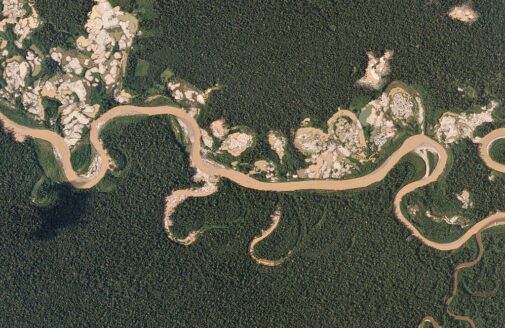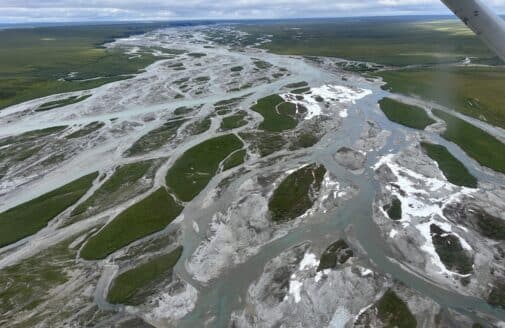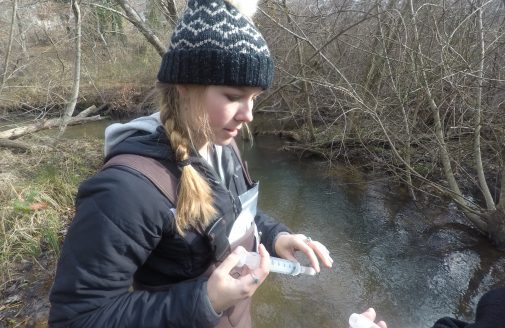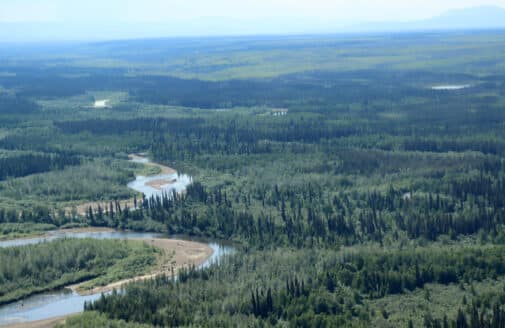Nitrogen retaining soil property protects tropical streams from impacts of agricultural intensification

Pit dug at Tanguro to sample soils.
photo by Christopher Neill
Quick facts
-
Some soils in the Amazon rainforest contain deep stores of nitrogen in the form of nitrate (NO3-), accumulating at a depth of 6-20 feet. Soil retains the ability to store large amounts of nitrate even after land is converted from forest to agriculture.
-
A new paper quantified the mechanism, a chemical characteristic of highly weathered clay soils called anion exchange capacity, which captures negatively charged nitrate ions as water passes through the positively charged soil. As a result, very little nitrate seeps into groundwater and surface streams from these soils even when croplands receive nitrogen fertilizer.
-
If well stewarded, many of Brazil’s Amazon croplands have a built-in buffer against water pollution that could potentially last decades. This is crucial for increasing crop production using fertilizer to reduce pressure for new deforestation, without the added consequence of nitrogen pollution of freshwater ecosystems that accompanies increased fertilization on croplands in other parts of the world.
A recent paper from Woodwell’s Tanguro Ranch Research Station has quantified a property locked into Brazil’s deep tropical soils that protects streams and rivers from the effects of fertilizer leaching and runoff. The study, led by Dr. Alexandra Huddell, a graduate student at Columbia University at the time of the study and now a postdoctoral fellow at the U.S. Environmental Protection Agency, estimated that, if well managed, Amazonian soils could continue to hold back excess nitrogen from reaching surface waters for many years, allowing for increased crop yields with relatively little impact on the surrounding ecosystem.
In temperate croplands—the midwestern U.S. breadbasket for example—some of the nitrogen in fertilizer that isn’t taken up by plants is converted to nitrate. Nitrate moves rapidly through soil and into groundwater, streams, and rivers. Excess nitrate threatens drinking water and causes algal blooms that can lead to low oxygen levels in lakes and coastal waters of oxygen.
But studies of the soils in Tanguro showed a very different dynamic. At Tanguro, the nitrate was sticking to the soil, not moving down towards groundwater and streams. Dr. Huddell’s study quantified the mechanism that led to such a stark difference between Tanguro’s soils and those of temperate cropland regions.
“We often think about increased agricultural intensification leading to decreases in local water quality, and this is an interesting case study of why that is not happening as quickly in Brazil,” said Dr. Huddell.
The difference is due to a molecular property inherent in the soil called “anion exchange capacity.”
Clay soils like the ones under the croplands of Tanguro and much of the Amazon rainforest form over millennia of intense weathering in the hot, wet climate, Huddell explained. Weathering produces minerals that impart positive charges to tiny soil particles. Nitrate, a negatively-charged ion (anion) then adheres to the positively charged soil. Most temperate zone soils are less weathered and have more negatively charged particles that repel nitrate–allowing it to move quickly to groundwater and streams.

infographic by Julianne Waite
Tropical rainforest soils (Oxisols) are created through extreme weathering that forms deep soil profiles and gives soil particles a positive charge. That charge attracts negative ions (anions) like nitrate (NO3-). In the southeast Amazon where commodity agriculture is intensifying, a new study conducted at the Tanguro Ranch Field Station found that these properties cause soils to accumulate nitrate deep in soil profiles. In contrast, in most temperate soils, excess nitrate from agriculture quickly washes through the soils and ends up in aquifers and streams where it is a major source of nutrient pollution.
Tanguro’s soils extend ten or more meters deep and have a large capacity for binding nitrate. That inherent property of the soil does not change when a forest is converted to agriculture.
“The mineral and structural composition of the soil don’t change much during conversion from forest to cropland, so the nitrate-retaining property is still present,” Woodwell Senior Scientist and co-author of the study, Dr. Christopher Neill says.
Dr. Huddell calculated that in this region, that capacity could last potentially for decades based on laboratory measurements. The precise timing will depend on factors like how much fertilizer is applied to croplands, whether water flows through some pores in the soil more than others and therefore bypasses portions of this anion exchange capacity, or if soil compaction at the surface reduces the water’s infiltration into the soil.
This finding has implications for slowing deforestation. Increasing crop yields on already converted land could increase Brazil’s agricultural output without destroying more of the Amazon Rainforest—a vital carbon sink. But intensification of fertilizer use only makes sense if it does not come at the expense of healthy freshwater ecosystems.
“If soils are well managed, you have this natural asset to keep the nutrients out of the water in ways we don’t have in the temperate zone,” Dr. Neill says. “We can likely intensify with more fertilizer use up to some level, and that will allow more food to be grown on less land, which could spare additional forest, but we need to better understand what those fertilizer limits are.”
Further investigation at Tanguro will test the limits of this capacity to narrow down the true size of this buffer.
Latest in Water

- In The News
Gold mining causes long-lasting damage in the Amazon rainforest

- In The News





